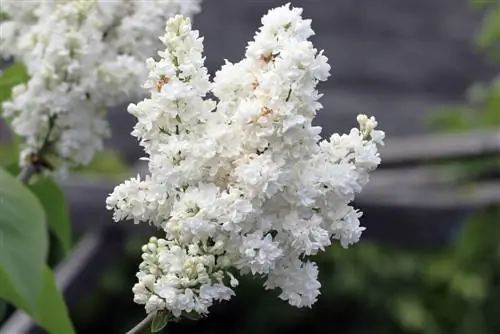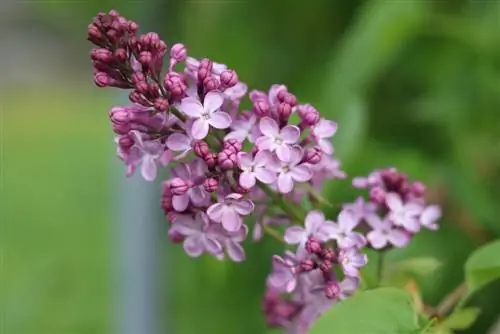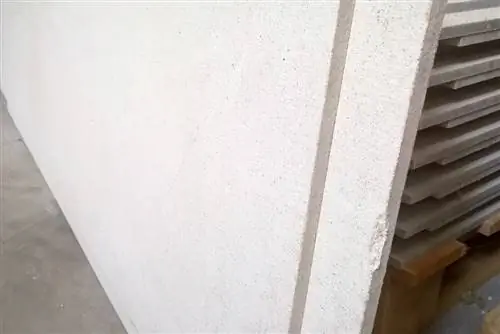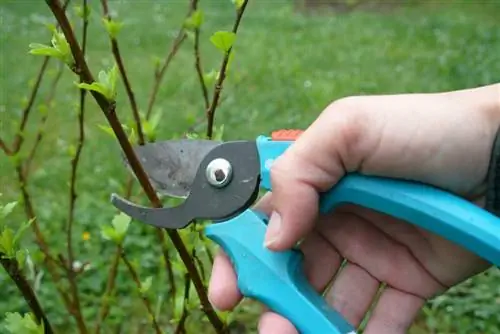- Author admin [email protected].
- Public 2023-12-17 03:39.
- Last modified 2025-01-24 12:45.
The first rays of sunshine in April and May cause the beautiful flower spikes of lilacs to sprout and exude their unmistakable scent. There are single and double flowers that open in pink, white to dark purple colors. If you want some exclusivity in the garden, you can plant a two-tone lilac.
The right location
The lilac loves the sun and feels extremely comfortable in it. Although it also thrives in partial shade, it doesn't impress with its abundance of flowers and lush crown. The blazing sun and strong heat are the companions of the lilac. The lilac is an ornamental shrub that is very wind-resistant and can be optimally planted as a hedge. After a few years, a fragrant and wonderful-looking privacy screen is created. If the lilac is in a sunny location and has sufficient soil moisture, it grows quite quickly. If the site conditions are right, the lilac can grow up to 50 cm annually. If it is planted as a hedge, you should give it enough space, one meter between the bushes.
- The location should be sunny,
- Lilac tolerates heat well,
- A sheltered place prevents its scent from wafting away.
Care
Lilac does not require any special conditions when it comes to soil. However, there should be no compacted soil or waterlogging. Lilacs that are already a few years old do not need regular watering, even in hot summers.
- It thrives particularly well on moderately dry, nutrient-rich, sandy/humous soil,
- Also thrives on clay soils that are permeable and dry in summer,
- Lilac wants a soil that is calcareous.
If the soil is sandy, adding fertilizer makes sense. Horn shavings or organic fertilizer are ideal fertilizers. If the lilac has perfect soil, it is sufficient to apply ripe compost to it in the spring. If the flower spikes turn brown, they should be removed with secateurs on a warm day. You can remove any annoying branches at the same time. You can prune lightly all year round.
Plant and propagate

When the lilac's flowering period is over, you can see shoots around it. These shoots can be easily propagated. They should be spotted in late summer. (But early autumn is still enough.) If they have already formed enough roots, they can be planted straight away. The hole for the sapling should be well watered with water. The little sapling also needs water in the following days. If the lilac shoot has not formed enough roots, you can put it in a bucket and let it root there. So that roots can form on the branch, pull a branch down to the ground and cover it with soil. After a few months, roots formed. The planting time for the lilac bush is in autumn or spring.
Fertilizing and watering
The lilac tolerates a dry, warm season better than too much moisture. Watering is quite minimal except when planted. But at the latest when the leaves become limp, watering is necessary. Otherwise
- Watering only necessary during long periods of drought.
- To create a rich sea of flowers, you should fertilize with a phosphorus emphasis.
- Organic fertilizer and compost are just as good,
- A layer of mulch is also suitable - this ensures an optimal temperature for the roots.
Cutting lilacs
The lilac doesn't necessarily have to be cut. The lilacs that have not been cut are in full bloom in May. Because the cut-friendly lilac shows great flowers on the two-year-old wood. The withered and brown inflorescences, but also the small branches, can be cut with sharp secateurs. But there are good reasons to cut the lilac, especially if it has become too big. It doesn't matter whether it's width or height.
The pruning should be even and the growth pattern of the wood should be maintained. To get it into shape, you can thin it slightly. If you cut the lilac annually and gently, the lilac will thank you with strong blooms, and at the same time the cut ensures dense growth. A caring cut should be done after flowering. To prevent wild growth, the brown flowers should be cut off. The cutting time should be done on warm days as the cuts dry more quickly, which in turn prevents pest infestation. A heavy pruning can be done once a year. However, you have to expect few or no flowers next year.
After a radical cut, which you have to carry out because it has become too big or too bushy, the lilac will grow quickly again. However, it takes two to three years until it is bushy again and has a large display of flowers. The lilac should only be cut radically in winter.
Since lilac is hardy, it does not need any special winter protection.
Pests and flowers that are too small
Lilac is not particularly susceptible to pests or diseases. The lilac moth, which can be recognized by brown, dried spots, can infest it. A fungal disease can also weaken the lilac tree. Only a change of location or chemical products can help.
If you have planted a lilac, there will usually be no flowers in the coming year. He first has to get used to his new location. If it doesn't bloom at all, it could be due to incorrect pruning, a summer that's too wet or over-fertilization.

There are wonderful varieties of lilac and new varieties are always coming onto the market. For example, there is:
- Noble lilac with purple double flowers, blooming very profusely, a popular hybrid.
- Lilac with purple flowers and white edges is also attractive.
What you should know in brief
- Lilac is a member of the olive tree family. It grows to a height of approx. 2-5 meters, depending on the variety and location.
- It loves a full sun location in humus-rich, permeable, loamy soil, which can also be a little calcareous.
- Partial shade is also tolerated well, although weaker flowers must be expected.
- Lilac cannot tolerate waterlogging at all.
- The lilac blooms in May and lasts until mid-late June. Flower colors are blue, white, reddish pink and new varieties also have yellow flowers.
- Lilac blossoms are very beautiful in the vase, but unfortunately they don't last very long. Never put lily of the valley together in a vase.
- The wild form has a very strong scent and therefore serves as a basis for new breeding.
- Propagation is done by cuttings, which are best cut in June after flowering.
Lilacs can be planted in spring and autumn. After flowering, you should cut off any dead flowers immediately (directly below the flower). The tree disc or base can be mulched, it is well tolerated. Lilacs are best fertilized with a potassium and phosphorus-based fertilizer.
You should also make sure that the lilac is planted deep enough so that the roots are not damaged when pulling weeds or raking. If the roots are damaged, shoots grow in the damaged areas and soon all you have left in the garden is lilacs. (Similar to the vinegar tree). It is better to plant the lilacs individually, rather than planting only bulbous flowers such as tulips, daffodils and crocuses, if possible together with the lilacs if they are planted in autumn. After a few years it has developed a dense network of roots and it is only worth sowing a few plants, such as Judas silver or night violet.
Bushy lilacs are often found as part of a flowering hedge. Since lilacs are particularly frost-resistant, low-growing species are also suitable for cultivation in containers. (At least you're safe from its offshoots). Some winter protection is required in the pot to prevent the roots from freezing. Above ground, lilacs are quite resistant to frost.






